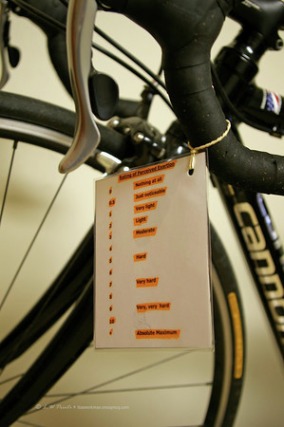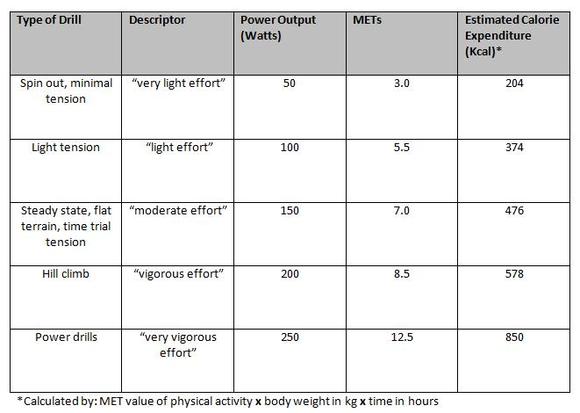|
I’d like to think of myself as an explorer, a fitness centre explorer. Any chance I get to go into a new facility I am giddy and excited like a child on Christmas morning. I like to explore gyms from large municipal facilities to hotel fitness rooms. The rush of seeing shiny equipment and learning about innovative programs is fun for me. I always want to know what physical activity opportunities are out there from both a business and personal curiosity perspective. About six months ago, I was driving by a new fitness centre and decided to go in to learn about what they had to offer. I always enter as a “lay” person and inquire about membership, ask for a tour and inquire about programs. I ask about spin/indoor cycling classes. In this one particular facility I inquired and the customer service representative was happy to tell me about their indoor cycling classes. She proceeded to tell me that a class can “burn up to 1400 calories” in 60 minutes. I tried not to let my face warp into an inquisitors’ expression, as I asked myself, what is the real number of calories one burns in an indoor cycling class? Well, one of my favourite resources was published in the journal Medicine and Science Sport and Exercise in 2000. Barbara Ainsworth has done extensive research on energy expenditure and physical activity and published the Compendium of Physical Activity. It outlines the metabolic equivalent (MET) for a lengthy list of activities. And we can use her work to help determine the answer...or at least a range of answers. First and foremost, we’ll assume your average cycle participant is 150 lbs (68 kg). Based on Ainsworth’s Compendium, your average cycle participant uses the following METs and estimated calorie expenditure per hour based on different drills or power outputs: Based on the calculations, an average indoor cycling participant doesn’t come near to what was quoted by the customer service representative, unless your cycle participants on average are 440 lbs (200 kg), and they are riding at a moderate effort. Are you surprised by the result? It turns out that body weight factors into the way energy expenditure is calculated and the results end up being highly personalized. As certified fitness leaders, it is our responsibility to provide our participants with correct information. Take the time to let your participants know their efforts are great but may not be an absorptive amount of calories that sometimes can be presented when pitching a program or new type of fitness class. Keep it realistic and maybe not bother quoting calorie expenditure. As we all know, there are many other benefits to riding that just burning calories!
2 Comments
As discussed in my last blog post, Rating of Perceived Exertion (RPE) is one way to monitor intensity in a cycle class. Being a visual learner myself, I appreciate any form of visual cueing during a cycle class. I have created individual RPE cards, which are affixed to each bike (see picture below for an example). I encourage cycle participants to use the card throughout the class to monitor intensity. The cards cover the modified Borg RPE scale (0-10), which seems to be easier to follow than the traditional Borg RPE scale (6-20). When I use the cards in class, I start with a brief overview of what the numbers represent and how the scale is a subjective assessment of each individual’s exertion level or intensity. Ensure to clearly describe! The following two drills are one way to use the cards in your class: To start, set a baseline tension and cadence to match a 3-4/10 for a moderate to somewhat hard exertion. This can be tricky to begin with so take time to let participants juggle tension and cadence to find the right balance.  1.Use tension only to set the exertion. Maintain a cadence of 80-90 rpm. Each section can be held for 30-60 seconds depending on the physical fitness of your group. Add tension to a rating of 5/10 (hard) Take tension off to a rating of 3/10 (moderate) Add tension to a rating of 7/10 (very hard) Take tension off to a rating of 2/10 (light) 2.Use cadence only to set the exertion. Maintain tension at moderate or slightly higher resistance (steady state tension). Each section can be held for 30-60 seconds depending on the physical fitness of your group. Increase cadence to a rating of 5/10 (hard) Decrease cadence to a rating of 3/10 (moderate) Increase cadence to a rating of 7/10 (very hard) Decrease cadence to a rating of 2/10 (light) These two drills give the cycle participants an opportunity to monitor their own exertion level, as well as, manipulate their exertion by using either tension or cadence. I would encourage asking cycle participants which version was more effective to mimic the assigned exertion level.
This is just one (visual) tool to help monitor exertion/intensity in a cycle class. Recently, two separate cycle participants have made comments about fitness leaders using percentages, such as “cycle at 50%”, in class. In both cases, the cycle participants both stated that they didn’t know what 50% means. They found it challenging (and frustrating) to interpret the percentages on the fly as they were being used in the class.
Monitoring intensity is an essential part of any cycling class. The difficulty lies in communication. Not only do instructors need to effectively communicate their intended intensity but they also rely on feedback from the participants indicating they are working at the intended intensity (something that is often difficult for the instructor to judge directly). Over the 10 plus years I have been teaching, I have explored a number of ways to describe and monitor intensity during cycle classes. I find a combination of various tools helpful: 1. A simple check of “How is everyone doing?” and interpreting the response from the group (i.e., no response means “I’m tired” and enthusiastic response means “I’m ready to push myself”). 2. Showing of hands in response to my questioning. For example, “I am doing great”, “I am doing so-so”, and “I am ready to get off my bike because I just can’t ride anymore”. 3. Setting a specific resistance and revolutions per minute (more to come in future blog posts) and having class participants continually check if they are maintaining the set intensity. 4. Individual Rating of Perceived Exertion cards that dictate how hard class participants are to work. If planning to use percentages to monitor intensity ensure the following: 1. Explain and explain again to ensure you are communicating how you would like class participants to quantify/qualify their intensity. 2. Consider discussing how to gauge individual intensity during the warm-up. Best to be on track from the start. 3. Use visual cues such as a Rating of Perceived Exertion poster or individual cue cards that explain what each level represents. 4. Ask for clarity from the group and if they understand how you would like them to monitor their intensity during the class. Using percentages is one way to monitor and describe intensity during a cycle class. Find the combination that works best for you and your class participants. |
Workman's Cycle Drills & Skills
Enjoy some of my favorite cycle workout drills either in a cycle class or on your own bike at home! Archives
September 2013
Categories
All
|
||||||
Edmonton, Alberta

 RSS Feed
RSS Feed